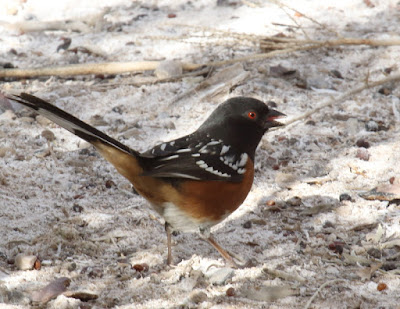Gold Butte, south of Mesquite, is one of the unsung treasures of Nevada, and would still be relatively unknown if it hadn't become involved recently in the "Sagebrush Rebellion". Now, I've always loved Nevada; it's known as the "poor man's Alaska" as it has more mountain ranges than any other state in the lower 48. I've backpacked the eastern Sierra Nevada for years, so when I discovered northern Nevada, with its mountains that look so different from the public perception of an empty, treeless land that you race through on Interstate 80, I was hooked. The Sierra is getting -- well, has been for awhile -- crowded, there's a permit system, and the bears are a problem. In the Nevada mountains, no permits are needed, there are no bears -- the basins of the "Basin and Range" landscape blocked them from wandering to the east -- the trails are blissfully uncrowded, even empty, and the scenery is just as magnificent. Two of my favorite Nevada mountain ranges are the Jarbidge in the northeast corner, and the Rubys, south of Elko. But there are also the Snake Range, with Great Basin Nat'l Park, which is more like the Rockies than the Sierra; the Santa Rosas and Pine Forest in the north, and drier ranges in central Nevada like the Toiyabe and Monitor. I really didn't become interested in the southern deserts, particularly here in the southeast, until I started spending parts of the winter here in the Moapa Valley about 3 years ago. Now I love this area just as much as the mountains to the north. And the scenery is much more unique here. Of course, I'd never want to visit during the summer months; this is, after all, a desert. But in winter and early spring, it's fabulous. So I was pretty much on a high when I was hiking in Gold Butte. Here are some landscapes, and let's see if you agree.
A huge sandstone monolith.

The folded and eroded landscape.
A wash runs through it. (No rivers here.)
A Joshua Tree frames the snow-dusted Virgin Mountains.
Reddish orange-colored sandstone, with Joshua Trees and the distant Virgins.
The clouds REALLY added to the scenery that day.
Some Joshua Trees can live to be a thousand years old. Here's what looks to be a venerable one with a trunk that looks like, well, a tree.
The dirt road crossing the Virgins and going into Arizona. (I'll have to take that next time.)
The southern part of the Virgin Mountains.
On the road through the Virgins -- Whitney Pockets, Gold Butte.
The Mormons named them Joshua Trees as they reminded them of Joshua extending his arms up towards Heaven. (I guess one of his arms got tired on this one.)
Now on to another relatively unknown gem here, the Moapa Valley National Wildlife Refuge (Facebook page at this link .) It's small, only about 100 acres, and the main reason for the refuge -- the riparian area -- is perhaps 4 acres at most. It's among all those palm trees in the distance --
There are 6 thermal springs here that create the Muddy River, which flows through the Moapa Valley. The refuge and surrounding area used to be a resort, with swimming pools taking advantage of the 90-degree temperature of the springs. When the resort closed, the area was restored to look more like it did previously (though the palm trees were put there by settlers and use up a lot of the water and are also a fire hazard) and the Moapa Dace, a tiny fish that's found only here at the headwaters of the Muddy, thrived once again. Here's the riparian area through which the springs come above ground --
And there's a neat, eye-level display where one of the springs has been re-routed so you can actually see into the flowing spring. Here are 2 of the fish, only at most 2 inches long. The Moapa Dace is on the left, and that may be the smaller Moapa White River Springfish on the right --
This next photo shows the cutaway of the spring flow so you can see the underwater habitat and fish, and there's a lot of signage info --
The Moapa Dace were, and still are, considered endangered, and you can read about species that, for one reason or another, are barely hanging on, or went extinct --
Though it's the middle of winter, there are good numbers of birds here as this is a lush area surrounded by desert. There are paths through the riparian area, benches and info displays. For such a small refuge, it's set up and maintained quite nicely. If you do go, say hello to "Vi" who, accompanied by her dog Hank, is the volunteer at the refuge who keeps it clean and tidy, and is a great source of refuge into --
This is the flow from one of the springs --
There's a trail that goes to the ridge above the refuge where you can get wide-ranging views of the upper Moapa Valley; you can see the shelter peeking behind the one palm tree --
From the observation area, you can get wide-ranging views of the upper Moapa Valley. I took this panorama from the ridge; those are the Mormon Mountains with Mormon Peak the highest one to the left, and Moapa Peak on the right --
While there I saw a flock of American Robins, White-crowned and Song Sparrows, Northern Flickers -- and this Spotted Towhee --
Oh, and also this large lizard --

The refuge is a great place to learn about the upper Moapa Valley, and the importance of water in this dry land. If you go, don't forget to say hi to Vi and Hank!





















thank you Steve for sharing new territory for me be careful
ReplyDelete